


M.A. Trossero
Miguel Angel Trossero is a Senior Forestry Officer in the Wood Products Division, FAO Forestry Department, Rome.
An overview of woodfuel issues at the beginning of the twenty-first century – problems and opportunities.
Several years ago, the energy sector initiated a “silent revolution” as a result of deregulation and liberalization policies enacted in most countries, followed more recently by reforms directed towards environmental protection and poverty reduction. Large public utilities have been fragmented and privatized. New smaller energy projects and initiatives have been undertaken making use of local expertise, labour, facilities and infrastructures, and resources (such as by-products) which previously went unused. This “revolution” has opened new opportunities for the development of renewable energy in general and wood energy in particular. Thus the panorama has changed in the two decades since Unasylva last dedicated an issue (No. 133, 1981) to fuelwood aspects and issues.
The changes have not been restricted to developing countries (such as Brazil, which pioneered the development of bioenergy as a local energy solution). Industrialized countries such as Austria, Canada, Finland, Germany, the Netherlands, Sweden and the United States have also adopted new energy policies with an increased utilization of wood energy within their “energy mix”.
Unfortunately, most of the old problems associated with wood energy – related to production and management of resources for fuelwood and charcoal and their use by the poorest people, with lengthy time and distance involved in fuelwood collection – still remain to be overcome. Similarly, the main concerns of public and private organizations involved in this field have not changed: insufficient management of woodfuel supply sources; the informal trade of fuelwood and charcoal; the inefficient conversion of fuelwood by households and small cottage industries, leading to pollution and health problems; as well as gender issues and policy matters – just to mention a few.
In addition, new problems regarding the industrial use of woodfuels are emerging as a result of new energy, environmental and forest policies developed to promote wider use of wood (and other biomass) for energy production. For instance, national capabilities for promoting and regulating wood energy systems are still weak in most places; social and economic concerns have been raised in many areas about the use of wood as fuel and its competition with other uses; international trade of woodfuels (including new liquid biofuels) is increasing in many parts of the world (see the short article by A. Faaij, p. 28) even though standards for its commercialization are not yet in place; and new technology is being developed but its transfer to the main users remains a great challenge for policy- and decision-makers.
Wood energy is gradually penetrating the new energy markets of industrialized countries as a clean and locally available source of energy. Meanwhile, in developing countries wood-based fuels remain the dominant source of energy for over 2†billion poor people. In these countries, woodfuels not only are vital to the nutrition of rural and urban households, but are also often essential in food processing industries for baking, brewing, smoking, curing and electricity production.
Analysis of different energy scenarios for both developed and developing countries (FAO, 1998; IEA, 2002) indicates that the demand for woodfuels will remain strong for many years to come. This is true even though the share of woodfuels in total energy demand is expected to decrease, as most developing countries have adopted energy policies aimed to promote use of other energy options by households, such as liquefied petroleum gas (LPG), bottled gas and kerosene. Moreover, the reduction in woodfuel’s share of energy consumption in developing countries is being largely compensated by the increased use of woodfuels for industrial energy (heat and power) in many developed countries as a result of environmental concerns.
It is expected that advances in knowledge and technology coupled with new policies will eventually contribute to more sustainable and cost-effective wood energy systems1† and to poverty alleviation, especially in poor areas of developing countries where a large wood energy potential remains untapped or where trees can be planted.
Wood energy is gradually penetrating new energy markets of industrialized countries as a clean and locally available source of energy – shown, wood pellet production in the Netherlands |
 |
M.A. TROSSERO |
In developing countries wood-based fuel remains a dominant source of energy; piles of wood scraps fuel this boiler for electricity production, Honduras |
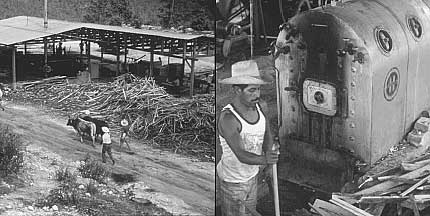 |
M.A. TROSSERO |
Existing information is too limited for a comprehensive analysis of the wood energy situation. Because of the decentralized nature of wood energy systems and inadequate national capabilities, energy and forestry statistics seldom include the same level of detail about woodfuel consumption as about other conventional energy sources, or about forest products. Moreover, the lack of uniform terminology, definitions, units and conversion factors makes it difficult to aggregate and compare the data that do exist.
FAO, through its Wood Energy Programme, together with many other organizations and with the financial support of the European Community (EC)-FAO Partnership Programme “Sustainable Forest Management Programme in African ACP Countries”, has been working for several years to help improve national capabilities and update and upgrade wood energy information systems at the national and international levels.
As a result of this process, a Unified Wood Energy Terminology has been created to facilitate data exchange between the major national and international organizations (see Box by D. Thršn, p. 10). A Guide for woodfuel surveys is being distributed; and existing and new data from different sources such as FAOSTAT (FAO’s statistical database), the United Nations Energy Yearbook and the series of FAO regional studies “Wood Energy Today for Tomorrow” are being collected and collated within a database, the Wood Energy Information System (WEIS).
Woodfuel statistics in WEIS differ from those in FAOSTAT in that they include statistics for black liquor, a by-product derived from pulp and paper making and used to generate energy for these industries. Black liquor generates a great amount of energy, and its inclusion in the database is important for estimating the contribution of woodfuel to total energy. However, the FAOSTAT forest product statistics do not include it because, as it is a derivative of other wood products, its inclusion would lead to double counting.
The woodfuel statistics in FAOSTAT have recently been revised, with a new method used to produce estimates for those countries that have not provided national data (see article by A. Whiteman, J. Broadhead and J. Bahdon, p. 41). The new statistics suggest that global woodfuel consumption is somewhat higher than was previously thought, but that growth trends in woodfuel use may be lower than was previously thought.
In global terms, woodfuels represent about 7 percent of the world’s total primary energy consumption. Most woodfuel use (76 percent) is in developing countries, where about 77 percent of the world’s population lives. About 44 percent of total woodfuel consumption is in Asian countries (Figure 1).
In the developing countries, wood energy represents approximately 15 percent of total primary energy consumption, although this figure conceals differences at the subregional and national levels (Figure 2). For example, in 34 countries in these regions woodfuels provide more than 70 percent of energy, and in 13†countries they provide 90 percent or more.
In developed countries woodfuels represent only 2 percent of total energy consumption (approximately 5†400 petajoules [PJ] [1†PJ = 1015 joules, equivalent to the energy produced from 100†000†m3 of wood]). This contribution rises to 14 percent if other biofuels are considered, however, thus reaching a share similar to that of other conventional energy sources such as coal, gas and electricity (FAO, 2002; IEA, 1997).
Wood energy contributions in developed countries also vary considerably from country to country. In Europe, for instance, the United Kingdom, Belgium and Germany make relatively little use of woodfuels, while in Finland, Sweden and Austria, wood energy provides 18, 16 and 12 percent of the demand, respectively (FAO, 1997a). Since 1990 France has been the largest consumer of wood for energy within the European Union (EU) at 370 PJ, but because of the magnitude of the country’s total energy demand, woodfuel use in France represents only 4 percent of the total energy supplies. Germany is also an important wood energy consumer, at 184 PJ, although wood energy supplies only a meagre 1.2 percent of the national primary energy used. In many countries, especially those of the former Soviet Union, there is virtually no information on wood energy.
Approximately 60 percent of the world’s total wood removals from forests and trees outside forests are used for energy purposes. In other words, woodfuel is one of the main products of forests and trees. While only 30 percent of the wood produced in developed countries is used for energy (33 percent in Europe and 29 percent in North America), in developing countries that amount reaches 80 percent. In Africa, Asia and Latin America woodfuels account for 89, 81 and 66 percent, respectively, of total wood consumption (Figure 3).
At the country level, the share of woodfuels within total wood consumption ranges from only 22 percent in Malaysia (which is in line with European countries) to 98 percent in Bangladesh, Cambodia, Nepal and Pakistan (FAO, 1997b).
Unfortunately, the paucity of woodfuel data already referred to makes it hard to assess the reliability of these figures and hampers the proper understanding of the contribution of wood energy in relation to energy from other sources. Incomplete and misleading national energy statistics result in distorted national, regional and international energy scenarios. Hence the importance of continued assistance to help countries improve their national wood energy information systems.
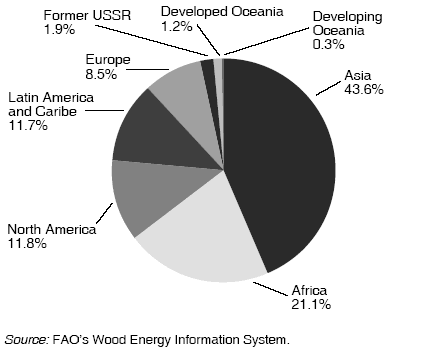 |
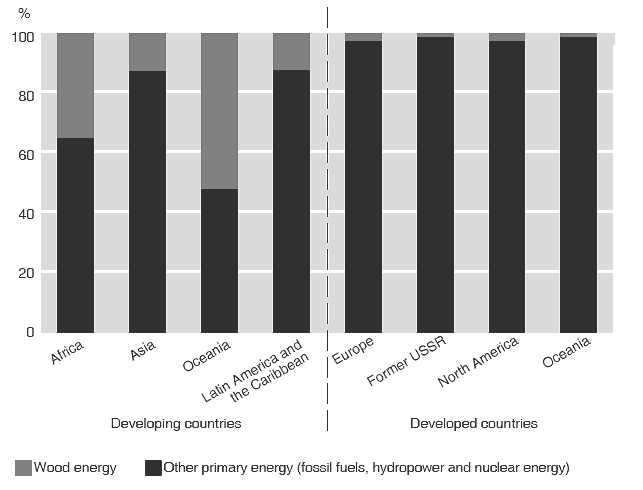 |
Source: FAO’s Wood Energy Information System. |
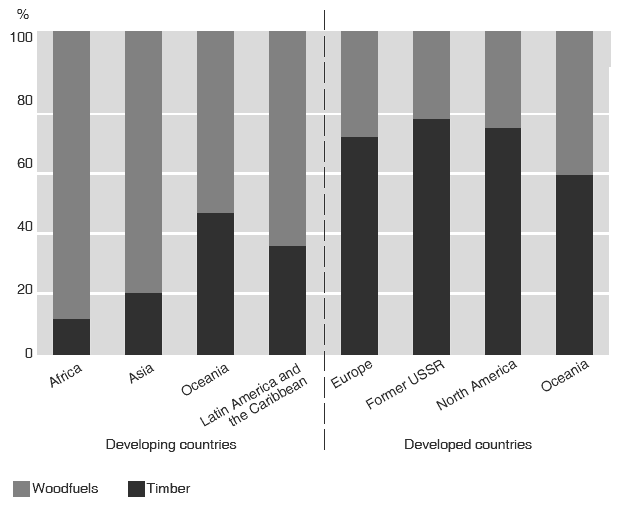 |
Source: FAO’s Wood Energy Information System. |
At any given location there are many different sources of woodfuels. They can be collected from dead trees, prunings and other woody wastes collected from forests, woodlands and trees in farming lands. In many areas, a substantial amount of woodfuels originates from the biomass produced by land clearing operations when forests and woodlands are transformed into agricultural farms. Considerable amounts of woodfuels are also obtained from trees planted on marginal and farming lands through agroforestry schemes (FAO, 1996).
However, in places with intensive utilization of woodfuels, for example around large urban centres and in zones with a high concentration of commercial activities like brick-making, lime burning and sugar production, pressure on fuelwood supply sources can be heavy, with consequent deforestation and/or devegetation. Such areas face fuelwood and charcoal shortages and depletion of wood stocks. Although fuelwood utilization for household cooking does not generally seem to face supply constraints, especially in rural areas, there are places in Haiti, the Andean highlands and the Sahelian countries, and around large cities such as the capitals of the Sudan, Senegal, Sierra Leone and Honduras, where there is clear and worrying pressure on forest resources. Therefore, generalizations about the sustainability of woodfuel use at the local level cannot be made without careful analysis in the field.
Area-based woodfuel flow studies carried out by FAO and other international organizations in countries such as Brazil, the Philippines, Pakistan, Mexico and Honduras have supplied essential information contributing to the understanding of the underlying dynamics of wood energy systems.
Figure 4 shows a typical area-based wood flow for energy and non-energy uses, with woodfuel types derived from different forest and non-forest supply sources (including trees outside forests, such as those planted under agroforestry and community tree-planting schemes). As shown, by products of forest industries (sawmills, particle board plants, etc.) often constitute an important source of woodfuel, particularly in developed countries.
Black liquor deserves special mention for the amount of energy it generates. The pulp and paper industries have so improved their energy efficiency and productivity that they generate electricity surpluses which can be sold to the public grid. This is another locally available, environmentally friendly and cost-effective wood-based energy source.
Unfortunately, data for area-based woodfuel flow analyses are not often available and their collection is expensive and requires skilled personnel. For this reason, FAO has developed Woodfuel Integrated Supply/Demand Overview Mapping (WISDOM), a spatially explicit method using geographic information system (GIS) technology for the representation and visualization of woodfuel consumption and production areas (see article by R. Drigo, O.R. Masera and M.A. Trossero, p. 36). WISDOM is expected to help in wood energy planning and policy development and in identifying priority areas of woodfuel shortage or of untapped wood energy potential.
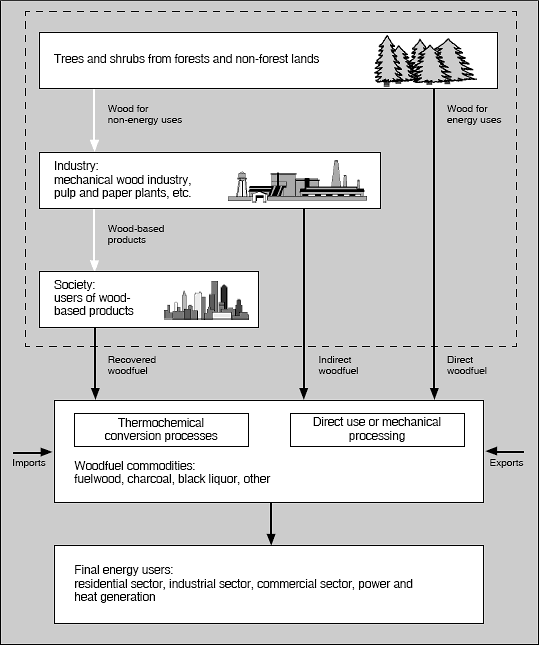 |
Energy is both an engine of development and a source of many of today’s economic and environmental problems. Access to affordable energy is essential to keep economies running. It is key to enhancing the productivity of industrial and commercial activities in urban as well as rural areas. Development benefits associated with renewable energy include the generation of rural jobs, urban and rural public health improvements and local self-reliance (G-8 Renewable Energy Task Force, 2001).
The economic value of woodfuels can be high. FAO estimated the value of the woodfuels consumed in 15 Asian countries, based on average calorific values and market prices for fuelwood and charcoal, to be the equivalent of US$29†billion per year (FAO, 1996). In Thailand in the mid-1990s, woodfuels contributed 30 percent of the total energy supply, with a value of approximately US$2 billion, which was more than 50 percent of the total energy import bill for 1994. A similar evaluation covering 15 European countries (FAO, 1997a) estimated that wood energy accounted for roughly €4†billion.
Growing trees and collecting and marketing woodfuels are labour-intensive activities (FAO, 2001). Studies based on a large household survey carried out by the United Nations Development Programme (UNDP)/World Bank Energy Sector Management Assistance Programme (ESMAP) found that fuelwood and charcoal are extremely important sources of employment and income for many rural households in developing countries (see Table). Of the various household fuels analysed, fuelwood and charcoal provide the greatest employment per standard unit of consumed energy. Petroleum fuels provide the least employment.
The European Union has forecast that the bioenergy sector will generate hundreds of thousands of full-time jobs in Europe by 2020, of which a large part will be in woodfuel production and use (see the short article by J. Domac, p. 18).
In many developing countries, unused residues from forests and forest industries represent a large untapped wood energy potential. This could be of immense importance for the future development of forestry and associated sectors and could help reduce fuel imports, leading to the redistribution of national incomes and macroeconomic benefits. Harnessing this potential could also enhance self-reliance through the use of local energy sources and provide microeconomic benefits such as income generation and improved equity, thus contributing to poverty reduction.
Various experiences reported worldwide, for example from Brazil, the Netherlands, Ireland, Nicaragua, some Asian countries and the European Union, support the notion that wood energy can help promote development, especially in rural areas where the most investment is needed and the generation of employment is the most difficult. This is not true for all countries in all periods, however, and depends on conditions in the country (FAO, 2001).
A government-supported community forestry nursery in Oaxaca, Mexico to raise trees for woodfuel, counteracting deforestation caused by previous overharvesting |
 |
M.A. TROSSERO |
Roadside marketing of fuelwood from mangroves, Sierra Leone |
 |
FAO FORESTRY DEPARTMENT/FO-0148/M.L. WILKIE |
A more diversified energy mix with a higher contribution of renewable energy is foreseen for the years ahead – driven by, among other things, environmental protection, climate change and poverty alleviation issues (UN, 2002; UNFCCC, 2002).
Wood energy has great potential as a locally available and environmentally friendly (relative to fossil fuels) source of energy. However, in the short term the transition towards its increased utilization will be dominated by economic factors – more specifically, the cost-effectiveness of the technology used and the associated subsidies and incentives provided not only for wood energy but also for fossil fuels and other conventional energy sources.
Woodfuels, like fossil fuels, can be used for the production of different types of fuels (solid, liquid and gaseous) and the generation of different kinds of energy (electricity, heat and power) needed by the industrial, commercial, household and transportation sectors. These characteristics are not encountered in other renewable energy sources such as solar and wind energy. However, the implementation of wood energy systems is considerably more complicated than that of conventional energy sources.
The technical and non-technical barriers to be removed in the years to come are many. For instance, new technologies are needed to make woodfuel more cost-effective and competitive with other energy options. New policies are needed for the development of woodfuel markets, for instance. Promoting woodfuel use can have many positive economic benefits including the creation of markets for biomass wastes; improved economic viability of thinning and harvesting; promotion of new crops, especially on marginal or unused agricultural land; and creation of employment in tree growing, harvesting, transport and conversion to useful energy.
A combination of factors, including those listed here, are expected eventually to contribute to overcoming the main barriers and to promoting the development of more sustainable woodfuel production systems.
In addition, a trend towards increasing use of processed wood-derived fuels suggests that, in the long term, the demand for biomass energy may increase not only in developed countries but also in developing countries, with increased industrial use offsetting an eventual decline in residential woodfuel demand.
A radical change in the policies of the forest and energy sectors is needed to ensure a positive climate for investment in wood energy. The expansion of woodfuel use in the power and industrial sectors suggests that decision-makers and planners in energy, environment and forestry agencies have begun to recognize the potential of wood energy. However, investment is particularly needed in those rural areas where fuelwood and charcoal remain the main source of energy and can become a motor for economic development and improved livelihoods.
Positive signs have been indicated in the recently approved Plan of Implementation of the World Summit on Sustainable Development, which called for countries to improve access to modern biomass technologies and fuelwood sources and supplies, to commercialize biomass operations in rural areas (where sustainable) and to promote the sustainable use of biomass and other renewable energies through improved management of resources, more efficient use of fuelwood and new or improved products and technologies (UN, 2002, Para. 9b,c). However, the mobilization of funds and resources for the implementation of wood energy initiatives remains the greatest challenge ahead.
Charcoal production provides employment and income for these workers in Argentina |
 |
M.A. TROSSERO |
 Bibliography
Bibliography
FAO. 1983. Fuelwood supplies in the developing countries, by M.R. de Montalembert & J. Clement. Rome.
FAO. 1996. Wood Energy News, 11(2). Bangkok, Thailand, FAO Regional Office for Asia and the Pacific.
FAO. 1997a. The role of wood energy in Europe and OECD. Wood Energy Today for Tomorrow –Regional Studies. Rome.
FAO. 1997b. The role of wood energy in Asia, by T. Lefevre, J.L. Todoc & G.R. Timilsina. Wood Energy Today for Tomorrow – Regional Studies. Rome.
FAO. 1998. Wood energy situation and trends, by M.A. Trossero, L.A. Horta Nogueira & T.J. Etherington. Contribution to the World Energy Council. Rome.
FAO. 2001. Socio-economic aspects of bioenergy: a focus on employment, by E.M. Remedio. Rome.
FAO. 2002. Wood Energy Information System (WEIS). Internet document: www.fao.org/forestry/FOP/FOPH/ENERGY/databa-e.stm
G-8 Renewable Energy Task Force. 2001. Renewable energy: development that lasts. Chairmen’s report. Available on the Internet: www.e-gazette.it/strument/G8-1.pdf
International Energy Agency (IEA). 1997. Biomass energy: key issues and priority needs. Conference proceedings. Paris.
IEA. 2002. Energy and poverty. In World Energy Outlook – 2002. Paris.
UN. 2002. Report of the World Summit on Sustainable Development, Johannesburg, South Africa, 26 August – 4 September 2002. A/CONF.199/20. New York, USA.
United Nations Framework Convention on Climate Change (UNFCCC). 2002. Agenda Item 11. High-level segment attended by ministers and senior officials. New Delhi, India, 23 October- 1 November 2002.
The “fuelwood crisis” that never happened During the “oil crisis” of the early 1980s, when the United Nations Conference on New and Renewable Sources of Energy took place (Nairobi, 1981), many international organizations were anxious to draw attention to another potential energy crisis: the “fuelwood crisis” affecting the daily energy supplies of approximately half of the world’s population, most of them poor people in the Third World. Many studies estimated that fuelwood consumption patterns could not be sustained by existing supply sources and forecast serious fuelwood scarcity problems in the years to come (e.g. FAO, 1983). Several factors contributed to this perception: high oil prices, rapid population growth, deforestation of large amount of forests and scarce access to other sources of energy. As a consequence of these assumptions, the use of fuelwood and charcoal was believed to be an irreparable cause of deforestation around urban and peri-urban areas, especially in fragile areas, notably in the Sahelian countries. The use of wood energy was thus considered a catalyst in a vicious circle of poverty and natural resources degradation. However, this “fuelwood crisis” never happened: the alarming woodfuel deficit situation predicted for many developing countries in the 1980s did not occur. The predictions were later understood to be the outcome of a limited and erroneous understanding of the dynamics of wood energy systems. At fault in particular was the assumption that forest resources were the main supply sources of fuelwood and charcoal. Studies carried out by FAO after the Nairobi Conference showed that woodfuel materials are obtained from many supply sources, not only from forest lands. They showed how people (especially women and children) gather their fuelwood mainly from “dead” wood, dry branches and twigs. A large volume of fuelwood is produced from trees planted with agricultural crops (agroforestry), fruit orchards, village woodlots, land around homes and community buildings (e.g. home gardens) and public lands (e.g. along roads, canals and rivers) (see Figure). In addition to trees, other woody plants, shrubs and bushes are also harvested for fuelwood. Other important sources of fuelwood include residues of wood harvesting and processing activities and wood recovered from urban dumps and construction activities – particularly important sources for urban users. In addition, a significant volume of fuelwood and charcoal is obtained through use of by-products from clear-cutting operations to convert forests to croplands, shifting cultivation, plantations or other land uses. Nevertheless, ensuring a sustainable woodfuel supply for the poorest people of the Third World remains a serious problem. For instance, more attention should be given today to the rising charcoal consumption associated with urbanization processes (see article by P. Girard, p. 30), as current charcoal making practices and techniques result in high pressure on forest and woodland resources. Fuelwood collection is also known to be a cause of deforestation around major cities and especially near refugee camps. In general, the problems of fuelwood have to be considered “part and parcel” of the problem of poverty. All the efforts carried out so far to improve the wood energy situation in developing countries through development of fuelwood resources, dissemination of improved stoves and enhancement of national and international capabilities are merely a drop in the ocean in relation to the magnitude and importance of the problems to be solved.
|